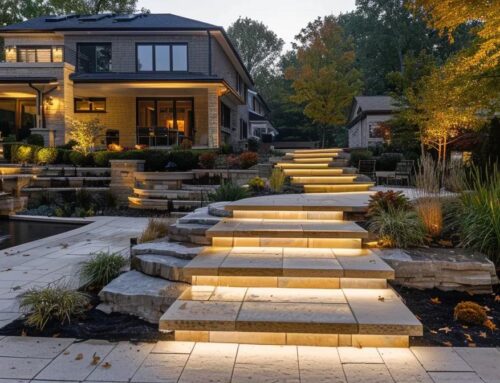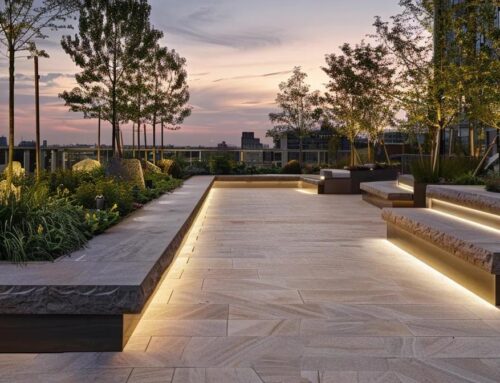Are you looking to refresh your outdoor space but unsure about the latest garden design trends? As more homeowners prioritize functionality and aesthetics, the focus has shifted towards designs that incorporate wildlife-friendly elements, sustainable materials, and the integration of technology. In this post, we will explore the rise of outdoor living areas, the benefits of foodscaping, and how to effectively manage stormwater in your garden. By understanding these trends, you’ll enhance your patio and create a beautiful, modern landscape that aligns with both interior design and environmental goals.
1. Embracing Minimalism in Outdoor Spaces

Understanding the principles of minimalistic garden design is essential for modern gardeners seeking a refreshing outdoor space. Selecting essential elements fosters a clutter-free environment, while effectively utilizing negative space enhances tranquility. Incorporating low-maintenance plants not only adds to the biodiversity of your landscape but aligns with the essence of modernism in garden design, as highlighted by bret-mar landscape and architectural digest, creating a harmonious balance that celebrates the soil’s natural beauty.
Understanding the Principles of Minimalistic Garden Design
In my experience, understanding minimalistic garden design involves focusing on sustainability and the selection of specific species that offer both beauty and functionality. Using materials like steel adds a modern touch while ensuring durability in your outdoor space. I often recommend integrating elements such as a meadow to create a serene and uncluttered environment, allowing the natural beauty of your landscape to shine through.
Selecting Essential Elements for a Clutter-Free Environment
When selecting essential elements for a clutter-free environment, I focus on choosing plants and materials that promote an environmentally friendly landscape. Using native species is key, as they are less likely to become invasive and require minimal maintenance, reducing the effort needed for care. For instance, incorporating drought-tolerant plants through xeriscaping not only conserves water but also simplifies upkeep, while well-placed vines can provide vertical interest without overwhelming the space.
Utilizing Negative Space Effectively
Utilizing negative space effectively is a key aspect of modern garden design that I find incredibly rewarding. By strategically placing elements such as a fire pit or concrete seating, I create areas that invite relaxation while allowing the surrounding landscape to breathe. This design technique not only enhances the beauty of pollinator-friendly plants but also simplifies irrigation needs, making maintenance easier while promoting a sustainable outdoor environment.
Incorporating Low-Maintenance Plants
When it comes to incorporating low-maintenance plants in a minimalistic design, I always recommend options that thrive without constant attention, allowing for a more enjoyable outdoor space. For example, using hardy shrubs and native grasses can reduce upkeep while providing a modern aesthetic that pairs well with features like pavers or a stylish fence. Additionally, low-maintenance houseplants can transition beautifully from your outdoor areas to your living room, creating a seamless harmony between your indoor and outdoor environments while inviting beneficial insects that support your garden’s ecosystem.
Minimalism clears the way for beauty, but there is more to consider. Sustainable materials breathe life into gardens, making them not just beautiful but enduring.
2. Sustainable Materials in Modern Gardens

Choosing eco-friendly hardscaping options is fundamental in modern landscape design, reflecting our commitment to sustainability. I will explore how recycled and upcycled materials contribute to creating durable habitats while incorporating the role of native plants in fostering local biodiversity. Finally, I’ll discuss designing for water conservation, which is essential in adapting to our changing climate, especially with options like drought-resistant bulbs.
Choosing Eco-Friendly Hardscaping Options
Choosing eco-friendly hardscaping options is vital for modern gardens, especially if you aim to create a sustainable landscape in your front yard. I often opt for materials like reclaimed stone or permeable pavers that not only complement native species but also support water conservation efforts. By incorporating these elements, along with perennial plants, we can cultivate a beautiful and responsible outdoor space that minimizes environmental impact while enhancing the overall aesthetics of your garden.
Exploring Recycled and Upcycled Materials
Using recycled and upcycled materials in garden design not only supports sustainability but also brings unique character to hardscape projects. For example, I often recommend incorporating reclaimed bricks or pavers, which can create stunning pathways while minimizing waste. Additionally, blending sand and compost in your garden beds fosters healthy soil, promoting plant growth even in drought conditions, and making your outdoor space both functional and environmentally friendly.
The Role of Native Plants in Sustainability
Integrating native plants into your landscaping is a key component of sustainable garden design, as they require less water and maintenance while supporting local ecosystems. For instance, native wildflowers can rejuvenate areas around a fireplace or patio, creating a natural beauty that enhances your outdoor atmosphere. I emphasize the importance of starting with seeds from native species; this approach not only contributes to biodiversity but also allows me to provide tailored landscaping services that align with eco-friendly practices, making your garden both beautiful and sustainable.
Designing for Water Conservation
Designing for water conservation is a key aspect of modern landscape design that I prioritize to create efficient and sustainable gardens. Implementing techniques such as drip irrigation or rain gardens allows for targeted watering while minimizing waste. By incorporating native plants and drought-resistant species, I can help foster community gardening efforts that not only enrich our local ecosystems but also reduce the overall demand for water, making maintenance easier and more environmentally friendly.
Sustainable materials lay the foundation for beauty and longevity in our gardens. As we embrace this harmony, technology offers new tools to shape our green spaces, inviting us to rethink their design.
3. Integrating Technology Into Garden Design

Integrating technology into garden design is transforming how we maintain our outdoor spaces. I will discuss smart irrigation systems that promote efficient watering, innovative outdoor lighting solutions with smart controls, and how utilizing apps can streamline garden planning and maintenance. Additionally, incorporating garden surveillance enhances safety, ensuring your garden remains both beautiful and secure.
Smart Irrigation Systems for Efficient Watering
Smart irrigation systems are a game-changer in modern garden design, allowing homeowners to optimize water usage efficiently. From my experience, these systems can be programmed to water specific areas based on weather conditions and soil moisture levels, significantly reducing water waste. I often recommend these technologies to clients who want a beautiful landscape that requires less maintenance and conserves resources, ensuring their gardens thrive while being environmentally conscious.
Outdoor Lighting Solutions With Smart Controls
Utilizing outdoor lighting solutions with smart controls has become a vital aspect of modern garden design, enhancing both beauty and functionality. In my work, I often recommend installing smart lighting systems that allow homeowners to easily adjust brightness, set schedules, and control lighting from their smartphones. This not only adds security to outdoor spaces but also creates inviting atmospheres for evening gatherings, ensuring the landscape remains a focal point even after sunset.
Utilizing Apps for Garden Planning and Maintenance
Utilizing apps for garden planning and maintenance has revolutionized how I approach landscape design. These tools help me map out garden layouts, choose appropriate plants, and stay organized with care schedules, making the process more efficient. For example, I often recommend apps that provide reminders for watering or fertilizing, which significantly helps homeowners manage their garden without feeling overwhelmed.
Incorporating Garden Surveillance for Safety
Incorporating garden surveillance is an innovative step toward enhancing safety in outdoor spaces. From my experience, strategically placed cameras not only help monitor garden activity but also deter potential intruders, making your landscape a secure retreat. This technology offers peace of mind, enabling homeowners to enjoy their beautiful gardens while ensuring their property remains protected, allowing them to focus on relaxation and enjoyment rather than worry.
As technology reshapes our gardens, we find ourselves drawn to the natural world. Biophilic design beckons, reminding us of our connection to nature and its power in our lives.
4. Biophilic Design and Its Influence

Biophilic design plays a crucial role in modern garden trends by enhancing our connection with nature. I will cover how integrating natural elements fosters sensory experiences and provides aesthetic appeal, ultimately creating spaces that promote well-being. Each of these aspects contributes valuable insights for homeowners looking to cultivate an outdoor environment that supports relaxation and happiness.
Enhancing Human Connection With Nature
Enhancing human connection with nature is a fundamental aspect of biophilic design that I strongly advocate in my landscaping projects. By incorporating elements such as water features, native plants, and natural materials, I create spaces that encourage interaction and engagement with the outdoor environment. For instance, constructing a small pond or adding stone pathways allows individuals to experience nature more intimately, deepening their appreciation for the beauty around them and promoting overall well-being.
Creating Sensory Experiences in Outdoor Spaces
Creating sensory experiences in outdoor spaces is vital for bringing a deeper connection to nature. I prioritize elements like fragrant flowers, varied textures, and gentle water features to engage the senses, inviting homeowners to experience the tranquility of their gardens fully. By integrating features such as tactile stone pathways or soft ornamental grasses, I help enhance the overall atmosphere, making outdoor areas not just visually appealing but also enriching and enjoyable for everyone who enters.
Using Natural Elements for Aesthetic Appeal
Incorporating natural elements into garden design significantly enhances aesthetic appeal and fosters a deeper connection with the environment. For example, using materials like natural stone, reclaimed wood, or bamboo not only adds texture and warmth but also blends seamlessly with the outdoor landscape. From my experience, elements such as rustic water features or naturalistic plant arrangements create inviting spaces that resonate with homeowners, making their gardens not just beautiful but also a source of tranquility and joy.
Designing Spaces That Promote Well-Being
Designing spaces that promote well-being involves creating environments where individuals can relax and rejuvenate. I focus on incorporating natural materials, soft colors, and tranquil elements such as water features to enhance the overall atmosphere of a garden. For example, integrating seating areas surrounded by lush greenery not only invites enjoyment of the outdoor space but also fosters a peaceful retreat from daily stress, allowing homeowners to truly connect with nature and themselves.
As nature draws us closer, our homes begin to reflect that bond. This shift leads us to embrace outdoor living areas, where comfort meets the beauty of the world outside.
5. The Rise of Outdoor Living Areas

The rise of outdoor living areas reflects a growing desire to extend our home’s functionality into the fresh air. In this section, I will discuss designing multifunctional patios and decks, creating cozy outdoor dining spaces, and incorporating outdoor kitchens. I’ll also highlight the benefits of establishing relaxation zones, all contributing to a seamless integration of comfort and nature in your landscape.
Designing Multifunctional Patios and Decks
Designing multifunctional patios and decks is essential for expanding your living space while enjoying the great outdoors. I often recommend creating areas that cater to various activities, such as relaxing with friends, hosting meals, or enjoying a quiet moment with nature. By incorporating elements like built-in seating, outdoor kitchens, and fire pits, homeowners can achieve a seamless blend of comfort and functionality, transforming their backyards into inviting extensions of their homes.
Creating Cozy Outdoor Dining Spaces
Creating cozy outdoor dining spaces is about making your backyard an inviting spot for meals and gatherings. From my experience, incorporating features like comfortable seating, ambient lighting, and a well-placed dining table can transform your space into a delightful retreat. I often suggest using materials that blend with your landscape, such as wooden tables or stone pavers, to enhance the atmosphere while ensuring functionality, allowing you to enjoy dining outdoors with family and friends.
Incorporating Outdoor Kitchens
Incorporating outdoor kitchens has become a popular trend in modern garden design, enhancing both functionality and enjoyment in outdoor spaces. From my experience, a well-designed outdoor kitchen not only makes cooking and entertaining more convenient but also allows families to gather and enjoy meals in a refreshing atmosphere. I often suggest including features like built-in grills, countertops, and seating areas that blend seamlessly with the landscape, creating a cohesive look that invites outdoor dining and socializing.
Benefits of Creating Relaxation Zones
Creating relaxation zones in outdoor living areas can dramatically improve your home’s appeal and usability. In my experience, having designated spaces with comfortable seating and natural surroundings allows homeowners to unwind and rejuvenate in their gardens. By incorporating elements like soft lighting and cozy furnishings, these areas provide a peaceful retreat, helping you escape daily stress while connecting with nature.
Outdoor living has brought us closer to nature, making our spaces feel like a retreat. As we embrace these new areas, seasonal and edible gardening trends offer fresh ways to enhance our experience.
6. Seasonal and Edible Gardening Trends

6. Seasonal and Edible Gardening Trends
Implementing seasonal planting strategies is essential for maximizing garden productivity while meeting the growing popularity of homegrown vegetables. I have seen firsthand how creative vertical gardens can transform small spaces into lush retreats. Additionally, incorporating herbs and edible flowers not only enhances aesthetics but also adds functional elements to your landscape. Let’s explore these exciting trends further.
Importance of Seasonal Planting Strategies
Implementing seasonal planting strategies is vital for maximizing garden productivity and flavor throughout the year. In my experience, rotating crops and incorporating seasonal vegetables not only enhances the overall harvest but also supports soil health by preventing nutrient depletion. For instance, I often advise homeowners to plant cool-season crops like lettuce and spinach in the early spring, followed by warm-season varieties such as tomatoes and peppers in the summer, ensuring a continuous supply of fresh produce while enjoying a vibrant and functional garden.
Emphasizing the Popularity of Homegrown Vegetables
The growing interest in homegrown vegetables reflects a shift towards healthier, sustainable living. In my experience, having a vegetable garden not only provides fresh produce right at your doorstep but also fosters a deeper connection to what you consume. I often encourage clients to start with easy-to-grow options like tomatoes or peppers, which can thrive in various spaces, turning even small yards into productive gardens that cater to their dietary needs while enhancing their outdoor environments.
Creative Vertical Gardens for Small Spaces
Creating vertical gardens is a fantastic solution for small spaces, allowing homeowners to maximize their gardening potential without occupying precious ground area. I often design these gardens using wall planters or trellises, which not only come in diverse styles but also support a variety of plants including herbs and vegetables. In my experience, vertical gardens can transform confined areas into lush greenery, making them perfect for urban environments while providing a practical way to produce fresh ingredients right at home.
Incorporating Herbs and Edible Flowers for Aesthetics and Function
Incorporating herbs and edible flowers into my garden designs is one of my favorite ways to combine beauty and functionality. These plants not only enhance the visual appeal of outdoor spaces but add flavor and freshness to meals right from the backyard. For instance, I encourage clients to integrate vibrant nasturtiums or fragrant rosemary alongside vegetables, making their gardens not just productive but also a delightful feast for the eyes and taste buds alike.
Conclusion
Exploring the latest modern garden design trends is essential for creating outdoor spaces that are both beautiful and functional. By embracing minimalism, incorporating sustainable materials, and integrating technology, homeowners can enhance their landscapes while promoting conservation and ease of maintenance. Focusing on seasonal planting and incorporating edible plants also adds value, providing fresh produce and fostering a deeper connection to nature. These trends reflect a commitment to sustainability and well-being, ensuring your garden becomes a true extension of your home.




